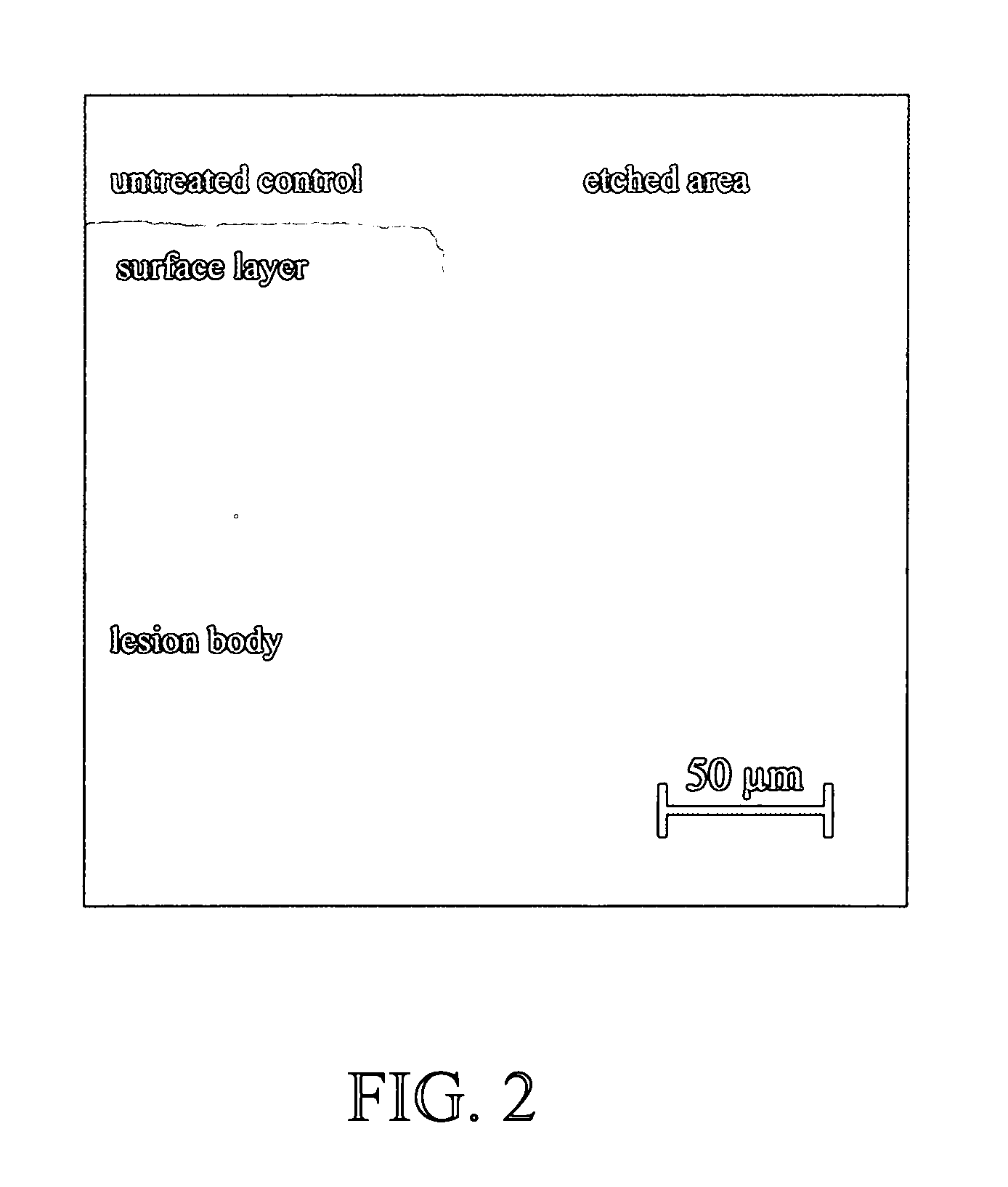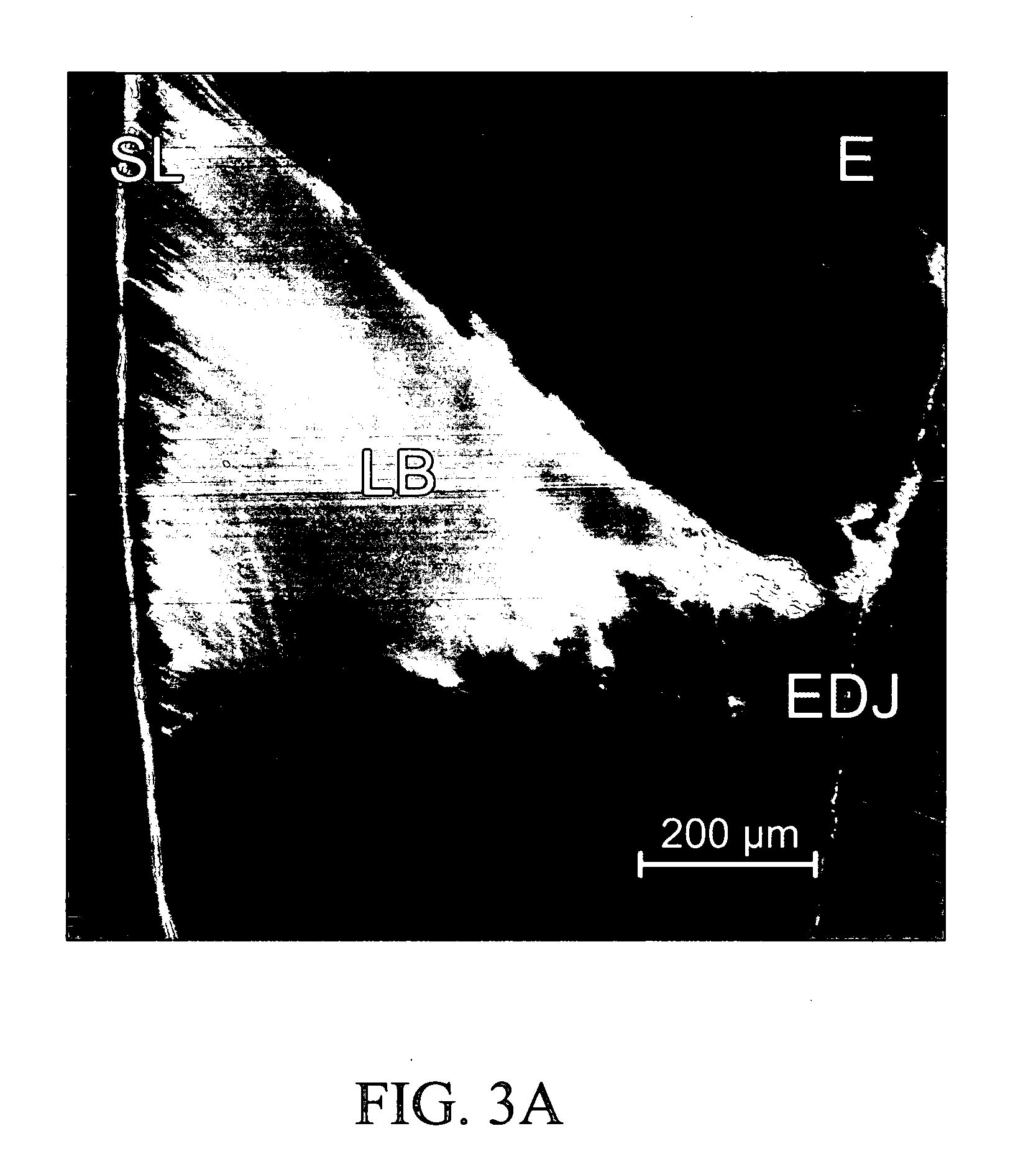Method of infiltrating enamel lesions
a technology of enamel lesions and infiltration methods, which is applied in the direction of impression caps, instruments, prostheses, etc., can solve the problems of difficult cleaning of approximal surfaces, difficult remineralization of approximal lesions that have reached dentin, and difficult remineralization of approximal lesions, etc., to achieve the effect of preventing and/or treating carious lesions
- Summary
- Abstract
- Description
- Claims
- Application Information
AI Technical Summary
Problems solved by technology
Method used
Image
Examples
example 1
Effect of the Pre-Treatment with a Conditioner Comprising Hydrochloric Acid
1. Material and methods
[0123] Extracted human molars and premolars, showing approximal white spots were cut across the demineralizations. One-hundred-twenty lesions confined to the outer enamel were selected. The cut surface as well as half of each lesion, thus serving as control, was covered with nail varnish. Subsequently, the lesions were etched with either phosphoric (37%) or hydrochloric (5% or 15%) acid gel for 30 to 120 seconds (n=10).
1.2 Visualization
[0124] The specimens were dried for 5 minutes in a silicone hose, closed at one end with a stopper, and separated with silicone rings. Subsequently, Spurr's resin (Spurr A R. A low-viscosity epoxy resin embedding medium for electron microscopy. J Ultrastruct Res, 1969, 26:31-43), labeled with 0.1 mmol / l of the fluorescent dye Rhodamine B Isothiocyanate (RITC), was doused over the specimens and the hose was closed with another...
example 2
Resin infiltration of natural caries lesions after etching with phosphoric and hydrochloric acid gels in vitro
1. Material and Methods
[0129] Extracted human molars and premolars showing proximal white spot lesions were used in this study. After careful cleaning from soft tissues teeth were stored in 20% ethanol solution up to usage. Teeth were examined using a 20× stereo microscope (Stemi SV 11; Carl Zeiss, Oberkochen, Germany) and cavitated as well as damaged lesions were excluded.
[0130] For radiographic examination teeth were positioned in a silicone base with the buccal aspect facing to the radiographic tube (Heliodent M D; Siemens, Bensheim, Germany). To simulate cheek scatter a 15 mm wall of clear Perspex was placed between the tube and the teeth. Standardized radiographs (0.12 seconds, 60 kV, 7.5 mA) were taken from each tooth (Ektaspeed; Kodak, Stuttgart, Germany) and developed using an automatic processor (XR 24-II; Dürr Dental, Bietigheim-Bissingen, Germany). The radiogr...
example 3
Evaluation of the PCs of Experimental Infiltrants
[0139] The aim of this investigation was the evaluation of the PCs of 66 experimental composite resins intended to infiltrate enamel lesions (infiltrants).
1. Material and Methods
[0140] A total of 66 experimental infiltrants containing two of the monomers BisGMA, UDMA, TEGDMA and HEMA in variable weight proportions each (100:0; 75:25; 50:50; 25:75; 0:100) as well as ethanol (0%, 10% or 20%) were prepared (Table 2). For each experimental resin, 10 g were mixed up in brown glass jars according to Table 2. To avoid premature polymerization, the resins were stored at 4° C. until use. To determine PCs of the experimental infiltrants, contact angles, surface tensions, and viscosities were measured.
TABLE 2Composition (weight percent) and measured results of experimental infiltrants.Means and standard deviations (SD) are given for contact angles, surface tensions,dynamic viscosities and resulting penetration coefficients (PCs). In additi...
PUM
| Property | Measurement | Unit |
|---|---|---|
| wavelength | aaaaa | aaaaa |
| wavelength maxima | aaaaa | aaaaa |
| wavelength maxima | aaaaa | aaaaa |
Abstract
Description
Claims
Application Information
 Login to View More
Login to View More - R&D
- Intellectual Property
- Life Sciences
- Materials
- Tech Scout
- Unparalleled Data Quality
- Higher Quality Content
- 60% Fewer Hallucinations
Browse by: Latest US Patents, China's latest patents, Technical Efficacy Thesaurus, Application Domain, Technology Topic, Popular Technical Reports.
© 2025 PatSnap. All rights reserved.Legal|Privacy policy|Modern Slavery Act Transparency Statement|Sitemap|About US| Contact US: help@patsnap.com



